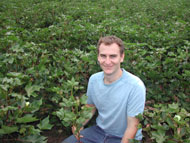
PhD studies target Fusarium wilt in cotton

The cotton industry is pinning its hope on new research into seedling diseases of cotton that is expected to shed new light on the management of the devastating disease known as Fusarium wilt.
This is the first solid research to explore a long-held theory that the fungus which causes Fusarium wilt in mature cotton plants also acts as a seedling pathogen causing pre and post-emergent disease in the first few weeks after sowing.
NSW Department of Primary Industries (DPI) plant pathologist Chris Anderson will investigate the role of the fungus and its interaction with other seedling pathogens during a three-year doctoral study.
Funded by the Cotton Research and Development Corporation and NSW DPI, the research comes after annual disease surveys revealed the disease has rapidly spread throughout major cotton growing areas since it was first discovered in 1994.
Mr Anderson said his research was an important first step in the development of control strategies for growers.
"The potential for seedling pathogens to cause stand loss is well known," Mr Anderson said.
"Now we want to find out if the Fusarium wilt fungus, both alone and together with other pathogens, is responsible for increased rates of seedling death and associated stand loss in Fusarium wilt fields.
"Our studies will focus on soil pathogens from different soil types and paddocks known to be infested by the fungus as well as paddocks free of the fungus, because pathogens can behave differently under certain environmental conditions.
"Once we identify the conditions that favour the interactions between pathogens, we will be able to develop effective disease management strategies to combat these interactions in the field."
A major emphasis will be placed on the impact of soil moisture, temperature and crop residues on the severity of seedling disease and the prevalence of one seedling pathogen over another.
Email:

